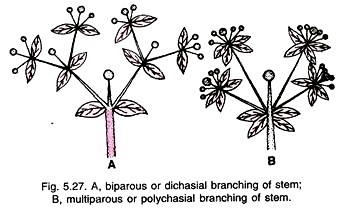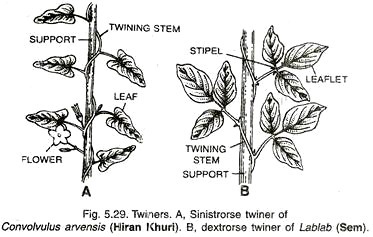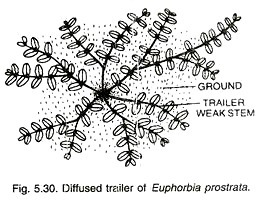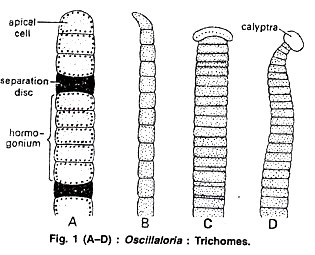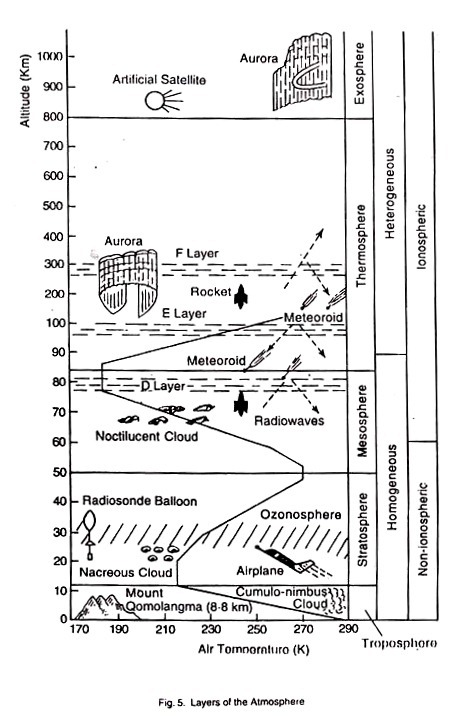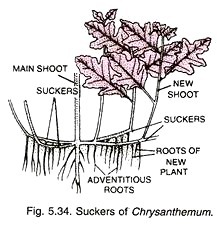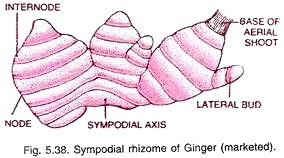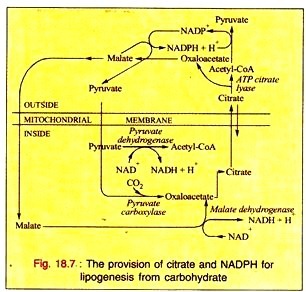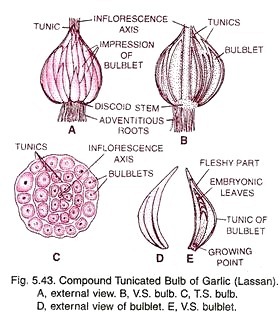In this article we will discuss about:- 1. Definition of Stem 2. Characteristics of Stem 3. Branching 4. Forms 5. Modification 6. Functions.
Definition of Stem:
Stem is usually the above-ground erect ascending part of the plant body that develops from the plumule, bears leaves and flowers, grows by means of a terminal bud and shows distinction of nodes and inter-modes.
The nodes bear leaves having axillary buds. The leaf bearing part of the stem or its branch is called shoot. Stem branches are exogenous in origin. Young stems are green, soft and pliable, older stems are dark brown, hard and woody.
Characteristics of Stem:
(i) Stem develops from the plumule of embryo,
(ii) Stem is generally the ascending; part of the plant axis,
(iii) It bears a terminal bud for growth in length,
(iv) The stem is differentiated into nodes and internodes.
(v) The stem nodes possess dissimilar appendages called leaves,
(vi) The young stem is green and capable of performing photosynthesis,
(vii) In the mature state it bears flowers and fruits,
(viii) Leaves and stem branches develop exogenously.
(ix) Stem exposes leaves, flowers and fruits to their most suitable position in the aerial environment for optimum function,
(x) Hair, if present, are commonly multicellular.
(xi) Stems are usually positively phototropic, negatively geotropic and negatively hydrotropic.
Branching of Stem:
Un-branched stem is called caudex or columnar, e.g., Palm, Sugarcane, Maize. Branching of the stem is of two types, dichotomous and lateral. Dichotomous branching is quite rare in angiosperms.
In dichotomous branching (Fig. 5.25 A) the growing point gets divided into two in the region of branching, e.g., Dictyota (an alga), Marchantia (a bryophyte). Dichotomous branching is rare in angiosperms, e.g., Asclepia syriaca, Pandanus (Screw pine), Hyphaene (a palm).
In lateral branching the growing point does not get divided. Lateral branching is of further two kinds, racemose and cymose. In racemose or monopodial branching (Fig. 5.25 B) the terminal bud continues its activity indefinitely.
The lateral branches are borne over it in an acropetal succession, i.e., older towards the base and younger towards the tip. The lateral branches do not compete with the main axis, e.g., Pinus, Eucalyptus, Casuarina, Polyalthia (Ashok Tree).
In cymose branching the terminal bud, after forming a small portion of the axis, either stops its activity or gets modified into a flower, tendril, thorn, etc. Further growth of the axis is continued by one or more axillary branches.
Accordingly it is of three types:
(a) Uniparous or Monochasial (Fig. 5.26):
When the terminal bud stops its activity, further growth is continued by a single axillary branch. Soon its bud also stops growth and the process is repeated. The main axis is formed by the fusion of bases of axillary branches and the main stem.
It is called sympodial axis (sympodium). The successive branches may develop on either both the sides when it is called scorpioid (e.g., Grape Vine) or on one side only when it is known as helicoid (e.g., Saraca). In Grape Vine the leaf-opposed tendrils represent the modified tips of branches, the bases of which have fused to form the axis.
(b) Biparous or Dichasial (Fig. 5.27 A):
After the stoppage of growth or modification of the terminal bud, further growth is continued by two axillary branches. The process is repeated. The axis is multipodial, e.g., Viscum (Mistletoe), Silene, Carissa carandas (vern. Karonda), Mirabilis jalapa (Four O’ Clock).
(c) Multiparous or Polychasial (Fig. 5.27 B):
After stoppage of growth by a terminal bud, growth is continued by a whorl of three or more axillary branches. The axis is multipodial, e.g., Euphorbia helioscopia, E. tirucalli, Croton.
Forms of Stem:
Stem may be aerial, sub-aerial or underground. Aerial stems are usually upright. They are erect or weak. Erect upright aerial stem may be branched or un-branched. The un-branched erect, stout cylindrical stem having scars and remnants of fallen leaves is called caudex.
It is found in palms. In bamboos the stem is jointed. It has hollow internodes and solid prominent nodes. Such a jointed stem is called culm. In a few monocots with underground stems, aerial shoots develop only for bearing flowers. A leafless shoot bearing flowers is called scape, e.g., onion, aroids, banana.
Weak aerial stems are either twiners or climbers. Sub-aerial stems are usually prostrate over the ground. They include trailers and creepers. In creepers the prostrate stems root at intervals. They are mainly of three types- runners, stolons and offsets. Most workers include suckers also in the category of creepers because their prostrate stems may be at the level of ground.
Modification of Stem:
Modifications are changes in form and function to suit varied needs like storage of food, reproductive growth and survival through un-favourable seasons, vegetative propagation, mechanical support, protection, photosynthesis, etc. Modifications occur in aerial, sub-aerial and underground stems.
Aerial Stems (Epiterranean Steins):
They are of three types— reduced, erect and weak.
I. Reduced Stems:
The stem is reduced to a small disc. Nodes and internodes are not distinguishable,
(i) A reduced green discoid stem occurs in the vegetative phase above the base of root in Radish, Carrot, Turnip, etc. Leaves are crowded together on these stems. They are called radical leaves,
(ii) In some aquatic plants (Lemna, Spirodela, Wolffia) the reduced discoid stem is green and flattened to float on the surface of water. It does not bear leaves (Fig. 5.28).
(iii) A reduced non-green stem is also found in underground structures called bulbs, e.g., Onion, Garlic, Lily.
II. Erect Stems:
They are the commonest type of aerial stems. The stems are sufficiently strong to remain erect or upright without any external support, e.g., Maize, Wheat, and Mango. Erect stems with swollen nodes or jointed stems are called culms (e.g., Bamboo). Un-branched erect stem is otherwise called caudex or columnar while the branched ones are either ex-current or deliquescent.
III. Weak Stems:
The stems are thin, soft and weak. They cannot stand erect and therefore, require a support. Weak stems can be upright or prostrate.
Upright Weak Stems:
They are of two kinds, twiners and climbers.
1. Twiners (Fig. 5.29):
The stem is long, flexible and sensitive. It can coil around an upright support like a rope (e.g., Lablab, Ipomoea, and Convolvulus). Depending upon the direction of coiling, twiners can be indifferent, sinistrorse (anticlockwise, upper coil disappears at observer’s right, e.g., Convolvulus, Fig. 5.29 A) and dextrorse (clockwise, upper coil disappears at observer’s left, e.g., Lablab, Fig. 5.29 B).
2. Climbers:
The stem is weak and flexible but is unable to coil around an upright support by itself. It requires the help of certain clasping or clinging structures.
Accordingly, climbers are of four types:
(a) Root Climbers:
The stem clings to the support by adventitious roots, e.g., Ivy, Betel Tecoma.
(b) Tendril Climbers:
Tendrils are green thread like sensitive structures which can coil around a support and help the weak-stemmed shoots to climb up.
Tendrils may be modified stems (e.g., Passiflora), floral buds (e.g., Antigonon), leaf (Lathyrus aphaca) or leaf part (e.g., Gloriosa, Pea, Clematis, and Smilax).
(c) Scramblers (Ramblers):
The stems are able to rise up a support by clinging to it with the help of curved thorns (e.g., Bougainvillea), floral stalk hooks (e.g., Artabotrys), leaflet hooks (Doxantha unguiscati), spines (e.g., climbing Asparagus) or pickles (e.g., climbing Rose),
(d) Lianas (=Lianes):
They are woody twiners or climbers, e.g., Phanera (=Bauhinia) vahlii. Both the climber and the twiner are weak stems which rise upwards a support for exposing their foliage and reproductive organs.
Prostrate or Sub-Aerial Weak Stems:
The weak stems take the support of ground for spreading and proper exposure of the leaves and reproductive organs. They are of two broad categories— trailers and creepers. The creepers root at intervals while trailers do not do so. Breaking of the different rooted parts help in vegetative reproduction in creepers. Creepers are of three kinds— runners, stolons and offsets.
1. Trailers (= Stragglers, Fig. 5.30):
The shoots trail or spread horizontally along the ground without rooting at intervals, e.g., Convolvulus microphyllus, Euphorbia prostrata, Tribulus.
Trailers are of two types— procumbent (branches flat on the ground, e.g., Tribulus, Convolvulus microphyllus (= Evolvolus) and decumbent (some branches partially vertical, e.g., Portulaca, Tridax). In diffused trailer, the branches spread in all directions, e.g., Boerhaavia diffusa, Euphorbia prostrata (Fig. 5.30). In others, the branches spread in one direction only.
2. Runners (Fig. 5.31):
They are special narrow, green, above ground horizontal or prostrate branches which develop at the bases of erect shoots called crowns. A number of runners arise from one erect shoot. They spread in different directions and ultimately bear new crowns and tufts of adventitious roots. The process is repeated. Each runner has generally one or more nodes. The nodes bear scale leaves and axillary buds.
The latter can also grow to form new aerial shoots or crowns, e.g., Lawn or Doob Grass (Cynodon dactyl on), Centella (= Hydrocotyle, vern Brahmi Booti), Oxalis. In Mint, the horizontal branches may be green and runner-like or underground and sucker like.
Runners may break due to injury or decay. It gives rise to a number of independent plants, e.g., Oxalis, Lawn Grass.
3. Stolons (Fig. 5.32):
They are elongated horizontal or arched runners which can cross over small obstacles, e.g., Jasmine, Wild Strawberry, and Peppermint. For this the tip of stolon generally grows above the level of ground. Each stolon has one or more nodes possessing scale leaves and axillary buds. The term stolon is sometimes used for underground runner, where the tip unlike sucker, does not come above-ground, e.g., Colocasia.
4. Offsets (Fig 5. 33):
They are one internode long small runners which are found in rosette plants at the ground or water level, e.g., Pistia (Water Lettuce), Eichhomia (Water Hyacinth).
Underground Stems (Underground Stem Modifications):
The underground or subterranean stems lie below the surface of the soil. They are non-green, store food and take part in perennation. Buds and roots occur over them. They can therefore, be used for vegetative propagation of the plants. Underground stems send up aerial shoots or leaves at intervals during the favourable seasons.
Underground stems can be differentiated from roots by:
(i) Absence of root cap.
(ii) Absence of root hair.
(iii) Presence of terminal bud.
(iv) Presence of nodes and internodes.
(v) Occurrence of foliage or scale leaves on the nodes,
(vi) Presence of axillary buds on the nodes,
(vii) Exogenous branching.
(viii) Stem-like internal structure.
Underground stems are of the following five types:
1. Sucker (Figs. 5.34-5.35):
It is a special non-green slender stem branch which arises from the underground base of an erect shoot or crown. It grows horizontally in the soil and ultimately comes out to form a new aerial shoot or crown.
The process is repeated. Each sucker has one or more nodes with scale leaves and axillary buds. The latter can also sprout to form new crowns, e.g., Chrysanthemum. Mint has sucker-like or runner-like lateral branches (Fig. 5.35).
Suckers also occur in Banana and Pineapple.
2. Rhizome (Figs. 5.36-5.38):
It is a perennial fleshy underground stem which continues its growth indefinitely in the soil producing new leaves or aerial shoots during the favourable season and perennation during the un-favourable season. The stem as usual is differentiated into nodes and internodes. Adventitious roots occur on the lower side.
Rhizome is of two types:
(a) Rootstock:
The rhizome is upright or oblique with the tip almost reaching the soil surface, e.g., fern Dryopteris (=Aspidium).It is generally un-branched (Fig. 5.36), an exception being Banana,
(b) Straggling:
The rhizome is horizontal.
It is generally branched. Branching may be:
(i) Racemose when the axis is monopodial, e.g., Water Lily, Lotus (Fig. 5.37), Saccharum
(ii) Uniparous cymose when the axis is sympodial, e.g., Ginger (Zingiber officinale, Fig. 5.38), Turmeric (Curcuma domestica), Canna.
3. Corm (Figs. 5.39-40):
It is a short, thick, swollen, usually un-branched, spherical or sub-spherical underground stem which grows vertically in the soil and is formed annually.
A corm bears a number of circular nodes with scales which represent thin sheathing leaf bases of fallen dead leaves. Axillary buds occur at places. The base contains a number of adventitious roots. Corm takes part in perennation. In the favourable season each corm gives rise to one or more aerial shoots from its buds.
The aerial shoots manufacture food and store the same at their bases where new corms are formed. The new corms appear either above (e.g., Freesia, Gladiolus) or the side (e.g., Colocasia) of the old corm. The aerial shoots die down during the un-favourable season. Examples are found in Colocasia (Saffron vem Kachalu), Freesia, and Crocus (vern. Kesar), Amorphophallus (Elephant-foot, vern Zamin-kand).
4. Bulb:
It is an underground pyriform-spherical structure that possesses a reduced convex or slightly conical disc-shaped stem and several fleshy scales enclosing a terminal bud. Axillary buds occur at places. The bulb possesses a number of adventitious roots arising from the lower side of the stem. Bulbs are of two types, tunicated and scaly.
(i) Tunicated (Layered or Laminate):
The bulb is covered by a sheath of dry membranous scales called tunic. The fleshy scales are arranged in a more or less concentric fashion. Tunicated bulbs are of further two kinds: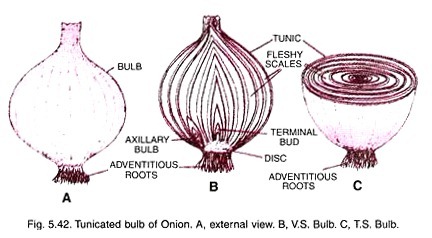
(a) Simple Tunicated Bulb (Fig. 5.42).
In Onion the fleshy scales represent leaf bases in the outer part and scale leaves in the central region. They occur in concentric fashion. The bulb is covered by a whitish or pinkish tunic. Other examples are Tulip and Narcissus,
(b) Compound Tunicated Bulb (Fig. 5.43):
It occurs in Garlic. The fleshy scales represent buds. The buds are sickle-shaped and are called bulblets or cloves. The bulblets occur in two or more somewhat irregular concentric rings around the central floral axis. Each ring is surrounded by a white membranous sheath or tunic. However, bulblets of a ring are imbricately arranged. A bulblet has its own thick white tunic, a fleshy zone and a growing point.
(ii) Scaly (Imbricate or Naked):
A tunic or covering sheath is absent. The fleshy scales are narrow and overlap one another on the margins only, e.g., Lily (Fig. 5.44).
Functions of Stem:
Primary Functions of Stem:
1. It bears and supports leaves, flowers and fruits.
2. The various appendages borne on the stem are placed in such a fashion that they are able to carry out their functions most effectively.
3. It conducts water and mineral salts from roots to the leaves and fruits.
4. The food manufactured in the leaves is transported to the roots, fruits and organs of storage through the stem.
5. Every year it adds new cells, tissues and organs which are required for the continued functioning of the plants.
Secondary or Accessory Functions of Stem:
1. Storage of food in its parenchymatous cells and underground portions like rhizomes (e.g., Ginger), corms (e.g., Colocasia) and tubers (e.g., Potato).
2. Storage of sugar as in the stems of Sugarcane.
3. Storage of water as in many succulents like Opuntia.
4. Floating on water, when aerenchymatous, e.g., Neptunia.
5. Perennation when underground (e.g., Mint, Saccharum, Dryopteris, Zinziber, Curcuma).
6. Manufacture of food in the younger state and when modified into phylloclades and cladodes (e.g., Opuntia, Asparagus, Ruscus).
7. To help in climbing by modifying itself into tendrils (e.g., Passiflora, Grape Vine), thorns (e.g., Bougainvillea) and hooks (e.g., Artabotrys).
8. Protection against grazing animals when modified into thorns (e.g., Duranta) or bears prickles (e.g., Rose).
9. Reduction of the rate of transpiration of the plant when modified into thorns (e.g., Alhagi, Duranta), phylloclades (e.g., Opuntia) or cladodes (e.g., Ruscus).
10. Means of vegetative reproduction as in case of runners (e.g., Grass), stolons (Strawberry), offsets (Eichhornia) and underground stems (e.g., Mint, Potato, etc.).
11. Sexual reproduction when modified into flowers.


